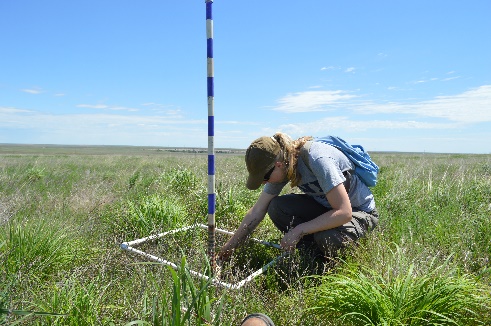How Spatial Heterogeneity Surrounding Leks Drives Lek Attendance by Lesser Prairie-Chickens
Investigators:
Jackie Gehrt
Dr. Dan Sullins
Project Supervisors:
Dr. David Haukos
Funding:
Kansas Department of Wildlife, Parks and Tourism,
USDA Natural Resources Conservation Service, Lesser Prairie-Chicken Initiative
Cooperators:
Kansas Department of Wildlife, Parks and Tourism,
USDA Natural Resources Conservation Service, Lesser Prairie-Chicken Initiative
Location:
Throughout Kansas and eastern Colorado
Completion:
August 2018
Status:
Completed
Objectives:
Examine vegetation characteristics at two spatial scales from the lek, the micro-habitat 100-m and lek landscape (5-km) scales, to assess which vegetation characteristics drive lek attendance
Quantify the presence and juxtaposition of nesting and brooding habitat across the northern portion of the Lesser Prairie-chicken range.
Assess the impact that potential brooding and nesting habitat surrounding leks have on lek attendance, especially by males, as described in the hotspot hypothesis
Progress and Results:
Contemporary lesser prairie-chicken populations have been on the decline since the mid-1980s. In response to these declines, the lesser prairie-chicken was briefly listed as threatened under the Endangered Species Act and numerous conservation efforts were launched to restore population abundance. Despite these measures, status of local populations remain uncertain. To better understand the cause of such dramatic population changes, perhaps we need to re-examine the understanding of reproductive habitat requirements to sustain a lesser prairie-chicken population. There have been many papers published that report the vegetative structure and location of successful nests as well as successful brood-rearing areas, but there is a gap in the literature on describing characteristics of successful leks in context of requirements to support the entire reproductive ecological state. To fill this knowledge gap while also addressing the issue of declining lesser prairie-chicken populations, we need to define drivers of lesser prairie-chicken lek site selection within the context of other reproductive requirements (i.e., nesting and brooding) that contributes to recruitment. Based on the literature, we quantified nesting habitat as points that have bare ground between 0-20% cover and average visual obstruction reading (VOR) at 75% coverage between 1.5-3.5 dm tall. Brooding habitat was defined as points that have 50% cover VOR readings between 2-5 dm, and forb cover within one standard deviation of the average between 7%-37%.
In effort to assess drivers of lek attendance, we found a strong correlation between lek attendance and VOR readings at the 5-km scale. We found that leks experienced highest attendance by both sexes when VOR readings at 75% coverage were between 1-2 dm which also falls within the desired VOR for suitable nesting habitat. When quantifying nesting and brooding habitat surrounding leks, we discovered that within all sites, 29.64% of locations within 5 km of a lek were available quality nesting habitat and 24.56% were available brooding habitat. Gove County in northwest Kansas had the most available nesting sites at 34.74% with Red Hills having the second most at 33.63%. Red Hills had the most available brooding sites at 32.98%. When assessing how these results affect lek attendance, we found that leks within the Red Hills study site experienced the most attendance with an average daily attendance of 12 birds. This supports the claim that birds are attend leks because of surrounding vegetation, specifically that which supports the nesting and brooding stages of reproductive ecology.

Products:
Professional Presentations:
Gehrt, J.A., D.S. Sullins, and D.A. Haukos. 2018. Looking at the bigger picture: how availability of nesting and brooding habitat influences lek-site selection by lesser prairie-chickens. Annual Meeting of The Wildlife Society, Cleveland, Ohio.